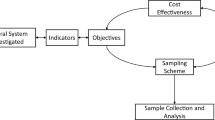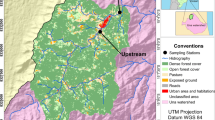Abstract
Diurnal water samples were collected simultaneously at four locations along High Ore Creek (Montana, USA), a small stream with near-neutral pH that contains elevated concentrations of Zn, Mn, Cd, and As from abandoned mines near its headwaters. During the same time period, two sets of synoptic samples were collected by workers moving in opposite directions along the stream. Large diurnal fluctuations in Zn concentration were found at three of the 24-h monitoring stations, but not at the outlet to a settling pond. Because the concentrations of Zn were dropping at most locations in the creek during the day (in response to the daily cycle of day-time attenuation and night-time release), the synoptic sampler who moved upstream obtained a data set that led to the conclusion that Zn load increased with distance downstream. The sampler who moved in a downstream direction obtained the opposite results. Thus, failure to take short-term diurnal cycling into account can lead to incorrect conclusions regarding spatial or temporal trends in water quality within a watershed.







Similar content being viewed by others
References
Bond BJ, Jones JA, Moore G, Phillips N, Post D, McDonnell JJ (2002) The zone of vegetation influence on baseflow revealed by diel patterns of streamflow and vegetation water use in a headwater basin. Hydrol Proc 16:1671–1677
Bourg ACM, Bertin C (1996) Diurnal variations in the water chemistry of a river contaminated by heavy metals. Natural biological cycling and anthropic influence. Water Air Soil Pollut 86:101–116
Brick CM, Moore JN (1996) Diel variation of trace metals in the upper Clark Fork River, Montana. Environ Sci Technol 30:1953–1960
Cleasby TE, Nimick DA (2002) Streamflow, water quality, and quantification of metal loading in the upper Tenmile Creek watershed, Lewis and Clark County, West-Central Montana, September, 1998. US Geological Survey, Water-Resources Invest Rep 02-4072
Gammons CH, Nimick DA, Parker SR, Cleasby TE, McCleskey RB (2005) Diel behavior of Fe and other heavy metals in a mountain stream with acidic to neutral pH: Fisher Creek, Montana, USA. Geochim Cosmochim Acta 69:2505–2516
Gelinas SL, Tupling R (2004) Monitoring remediation; have mine-waste and mill-tailings removal and flood-plain restoration been successful in the High Ore Creek valley? US Geol Surv Prof Pap 1652:461–473
Haack EA, Warren LA (2003) Biofilm hydrous manganese oxyhydroxides and metal dynamics in acid rock drainage. Environ Sci Technol 37:4138–4147
Harrison JA, Matson PA, Fendorf SE (2005) Effects of a diel oxygen cycle on nitrogen transformations and greenhouse gas emissions in a eutrophied subtropical stream. Aquat Sci 67:308–315
Hartley AM, House WA, Leadbeater BSC, Callow ME (1996) The use of microelectrodes to study precipitation of calcite upon algal biofilms. J Colloid Interface Sci 183:498–505
Kimball BA, Runkel RL, Walton-Day K, Bencala KE (2002) Assessment of metal loads in watersheds affected by acid mine drainage by using tracer injection and synoptic sampling; Cement Creek, Colorado, USA. Appl Geochem 17:1183–1207
Lambing JH, Nimick DA, Cleasby TE (2004) Short-term variation of trace-element concentrations during base flow and rainfall runoff in small basins, August 1999. US Geol Surv Prof Pap 1652:267–278
Montana DEQ (1996) Abandoned hardrock mine priority sites: 1995 supplemental summary report. Montana Dept Environ Quality. Abandoned Mine Reclamation Bur, Helena
Montana DEQ (2006) Montana numeric water quality standards. Montana Dept Environ Quality, Circular DEQ-7
Morris JM, Nimick DA, Farag AM, Meyer JS (2005) Does biofilm contribute to diel cycling of Zn in High Ore Creek, Montana? Biogeochem 76:233–259
Nimick DA, Gammons CH, Cleasby TE, Madison JP, Skaar D, Brick CM (2003) Diel cycles in dissolved metal concentrations in streams—occurrence and possible causes. Water Resour Res 39:1247. doi:10.1029/WR001571
Nimick DA, Church SE, Finger SE (eds) (2004) Integrated investigations of environmental effects of historical mining in the Basin and Boulder mining districts, Boulder River watershed, Jefferson County, Montana. US Geol Surv Prof Pap 1652:502
Nimick DA, Cleasby TE, McCleskey RB (2005) Seasonality of diel cycles of dissolved trace metal concentrations in a Rocky Mountain stream. Environ Geol 47:603–614
Roby RNW, Ackerman WC, Fulkerson FB, Crowley FA (1960) Mines and mineral deposits (except fuels), Jefferson County. Montana Bur Mines Geol Bull 16:26
Sherman DM, Randall SR (2003) Surface complexation of arsenic(V) to iron(III) (hydr)oxides; structural mechanism from ab initio molecular geometries and EXAFS spectroscopy. Geochim Cosmochim Acta 67:4223–4230
Shope CL (2003) Field and laboratory investigation of the hydrogeochemistry of High Ore Creek, Basin, Montana. MS Thesis, Montana Tech of The Univ of Montana
Shope CL, Xie Y, Gammons CH (2006) The influence of hydrous Mn–Zn oxides on diel cycling of Zn in an alkaline stream draining abandoned mine lands. Appl Geochem 21:476–491
Sudbrink A (2007) Investigation of contaminated groundwater within the Comet Mine reclamation site, High Ore Creek drainage basin, Southwest Montana. MS Thesis, Montana Tech of The Univ of Montana
Tate CM, Broshears RE, McKnight DM (1995) Phosphate dynamics in an acidic mountain stream: interactions involving algal uptake, sorption by iron oxide, and photoreduction. Limnol Oceanogr 40:939–946
Wayland KG, Long DT, Hyndman DW, Pijanowski BC, Woodhams SM, Haack SK (2003) Indentifying relationships between baseflow geochemistry and land use with synoptic sampling and R-mode factor analysis. J Environ Qual 32:180–190
Acknowledgments
Funding for this work was provided by grants from the US Environmental Protection Agency and the Montana Board of Research and Commercialization Technology. We thank James Madison for help with the field work, and David Nimick (USGS-Helena) for his continued collaboration on this and other projects dealing with diurnal metal cycling.
Author information
Authors and Affiliations
Corresponding author
Rights and permissions
About this article
Cite this article
Gammons, C.H., Milodragovich, L. & Belanger-Woods, J. Influence of diurnal cycles on metal concentrations and loads in streams draining abandoned mine lands: an example from High Ore Creek, Montana. Environ Geol 53, 611–622 (2007). https://doi.org/10.1007/s00254-007-0676-z
Received:
Accepted:
Published:
Issue Date:
DOI: https://doi.org/10.1007/s00254-007-0676-z




